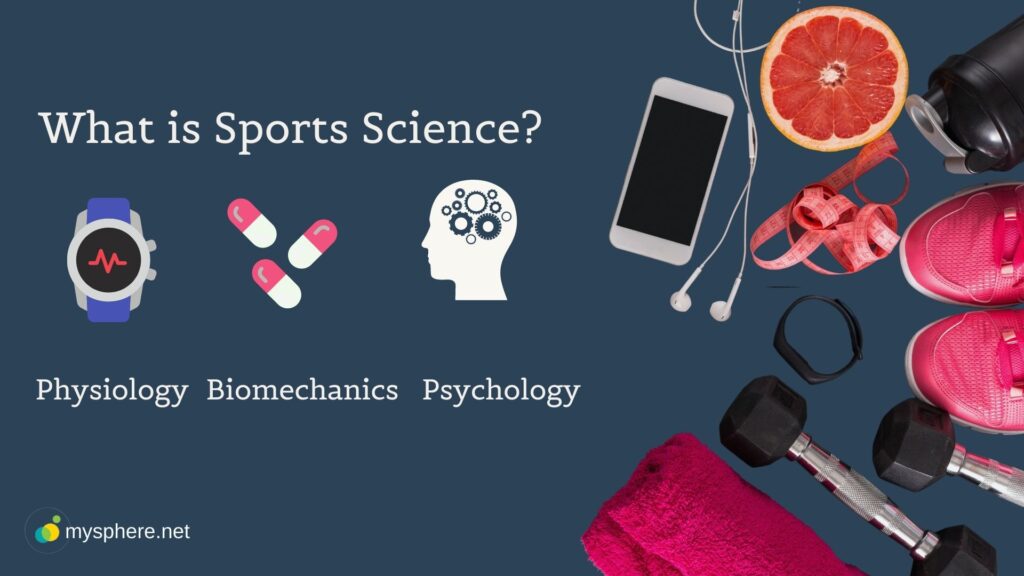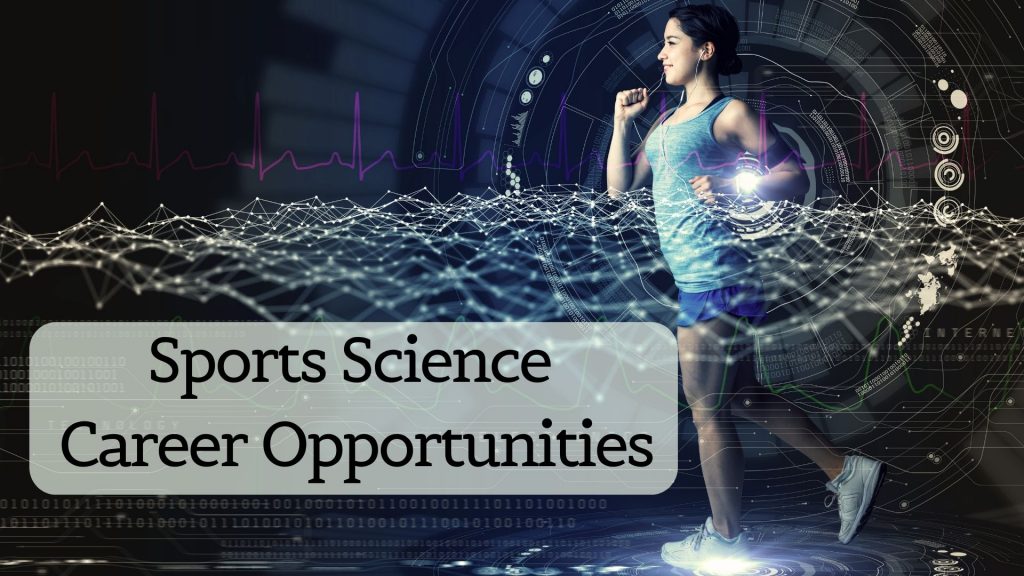The excitement on the field, the team spirit, the adrenalin rush, the pride after winning a game and the plain joy of playing are some of the reasons that attract youth to sports. The players and athletes rule the screens. The thorough training and the hard work needed to achieve excellence are also known to us. Ever wondered, apart from the training, what goes into making any sporting event an unforgettable experience for the audience and getting the sportsperson to perform at their best?
A multidisciplinary team of sports scientists works behind the scenes to ensure that each runner, swimmer, gymnast or player is in peak physical and mental condition to perform at their absolute best. As a result, new fields of study, such as sports science, have emerged to improve the quality of sports and fitness.
You might think that ‘sports science’ or ‘exercise science’ is all about exercising and participating in sports, but that is not the case. There’s a lot more going on. Read on to learn more about it. This article talks about sports science, sports and exercise science job options and how one can become a sports scientist.
What is Sports Science?
Sports science is the study of the functioning of your body and mind, and it deals with the theory and principles to do sports or exercise. To give you a broad overview, sports science covers the following topics:
- Physiology: This branch studies the human body’s response to exercise and training.
- Biomechanics: It aims at understanding the human body’s response to exercise by studying the causes and effects of muscular movement.
- Psychology: This branch studies the human mind in terms of sport and exercise.

From cellular to whole-body views, sports science examines how the healthy human body functions during exercise and how sport and physical activity improve health and performance. Physiology, psychology, anatomy, biomechanics, biochemistry, and biokinetics are all included in the study of sports science.
To help athletes train hard and stay healthy, teams are now focusing on performance through sports science. It is now the responsibility of sports scientists to determine whether data is meaningful and what it means for performance. As a broad field in sports, Sports Science, also known as Kinesiology, examines various theories and methods for doing sports and exercising in the most scientific way possible. If you want to be associated with sports in some way or the other way, a career in sports science could be worth considering. Let us understand what is the difference between Kinesiology and Exercise Science.
Kinesiology vs Exercise Science
Though kinesiology and exercise science both share the same focus on physical activity, there are some distinctions between these two fields.
Kinesiology focuses on how physical activity impacts health and quality of life. It is a broad field that encompasses several other areas of study, as mentioned below:
- Exercise science
- Sports management
- Athletic training
- Sports medicine
- Sport and exercise physiology
- Fitness leadership
- Physical education
- Pre-professional training for physical therapy, occupational therapy, medicine and other health fields
Kinesiology studies the relationship of physical activity with health and quality of life. The body movements, function and performance are studied in Kinesiology to see how they affect overall health.
Exercise science is a sub-field of kinesiology. It focuses on exercise and movement, how someone’s body changes through exercise and the resulting performance and health implications.
What do sports scientists do?
Whether it’s in elite performance sports or the impact on youngsters and the elderly in the community, sports scientists are obsessed with knowing how the human body operates under varying levels of pressure. Sports scientists analyse the amount of energy the body uses while performing a particular movement and then optimise the physical system for improved performance. When technology is integrated into sports science, it helps sportsperson reach their goals.
There are typically three main areas in which sport and exercise scientists work:
- Psychology: This includes how the mind works and which factors drive different behaviours. For example, helping athletes to improve their skills following severe injuries or trauma.
- Biomechanics: Focuses on understanding the human body’s mechanical aspects (function and motion). For example, sports movement – better batting techniques in cricket to improve performance.
- Physiology: Focuses on understanding the function of the organs and systems of the human body. How do these systems respond during sport and exercise. For example – Developing an appropriate training program based on the response received for exercise.
The elite sport relies on science to help athletes train safely. Data scientists are also using wearable sensors and machine-learning techniques to prevent injuries. In today’s time, wearable devices can monitor anything from blood pressure to sleep quality. These technologies have now made their way into the realm of athletics. Sports scientists today employ data and technology to benefit athletes of all levels. Though the basics remain the same, every human body responds to physical training differently. A training schedule that works for one player may not work for the other. The data and observations help the sports scientist to customize a training plan that works best for them. So it would not be wrong to say, now is the time when ‘data’ has a significant impact and revolutionizes how people are getting trained and competing.
Sport and exercise scientists help people improve their sporting performance, recover from injuries or better their general health and wellbeing. Sports scientists analyse the amount of energy the body uses while performing a particular movement and then optimise the physical system for improved performance. When technology is integrated into sports science, it helps sportsperson reach their goals.
What does a sports scientist’s day look like?
- Small GPS trackers, accelerometer and gyroscope sensors are attached to harnesses to capture data on how hard athletes’ bodies work during training and competition, allowing them to optimize their training and performance. How far did an athlete run? How much time did an athlete spend sprinting? How many times did they come to a hard stop? Sports science specialists can create a more comprehensive athlete profile using these numbers. They work with coaches to alter training regimens based on their data-driven insights to achieve optimal health and readiness. Here is a glimpse of A day in a life of a Sports Scientist.
- In endurance events, such as the marathon, mitochondria play a crucial role in determining success. Sports such as baseball and cricket need athletes to hit a ball moving at extraordinary speeds, and some coaches are turning to virtual reality to offer their players an advantage. As for gut microbes and athletic performance, microbiologists are just getting started.
- With data-driven tools and cutting-edge technology, athletes can find the sweet spot between growing healthy muscle for peak performance and lowering their risk of injury while achieving peak performance.
- Trainers must first learn how athletes move to help them move quicker and more efficiently. With the help of high-speed video cameras, sports science experts may closely examine body mechanics from multiple perspectives in second-by-second detail. In addition, it highlights troublesome actions that could lead to injury or offer chances to increase power or precision.
What are the opportunities in sports science?
Now, the important question is what jobs can you get with a sports science degree? Well here is the answer, the demand for sports scientists and performance consultants is expanding, as is the number of jobs available with the sporting world striving to achieve the greatest possible results. Researchers have understood how the human body responds to exercise, training, varied settings and many other stimuli via the scientific study of sport.
Some of the career opportunities in sports science are listed below:
- Sports and Performance Scientist
- Cardiac Physiologist
- Health Promotion Officer
- Public Health Scientist
- Performance Analyst
- Strength and Conditioning Practitioner
- Sports psychology
- Sports management
- Sports nutrition
- Academic research
- Personal training
- Physiotherapy
- Professional coaching
- Sports journalism
How to pursue a career in Sports Science?
To build a career in sports science, firstly, one needs to have a solid foundation in the subject areas it covers. It is recommended to understand basic sciences (biology, chemistry and physics) for someone who wants to get into exercise science. These curated introductory resources give an overview of what a career in sports science looks like, the opportunities and challenges, and much more.
Some of the selected institutions and universities offer courses in sports science. Having Physics, Chemistry and Biology subjects in the 12th class will help if you wish to pursue a bachelor’s in science or Sports Science. Another option is to study for your master’s abroad, increasing your exposure to global prospects.
While studying or after course completion, try to get as much work experience as possible. It could be through an internship or a part-time job. This work experience would help you understand what happens in the laboratory and basic science and what goes on in the field. You can learn more from these Notable Personalities in sports science and get inspired by their work.
If you are a sports enthusiast, you may want to explore studying this field in addition to practising your sport to gain a better understanding of sports. So next time when you are at the play, don’t forget that there is a lot more at the play other than the sport itself.
FAQs on a career in sports science
#1 Which all subjects does sports science include?
Sports Science includes various subjects such as physiology, psychology, biomechanics, chemistry biology and statistics.
#2 Where do sports scientists work?
Sports scientists work as consultants at a sports club, gym, hospital or healthcare centre. They also may have to visit different places depending upon their clients and work schedule.
#3 How do sports scientists help athletes?
Sports scientists work with athletes to help them attain their best performance. They do research analysis and provide advice on training in all sports areas.
#4 What is the duration of the sports science course?
At the undergraduate (bachelor’s) level, sports science degrees usually last three or four years and one or two years at the master’s level.
#5 What does a sports scientist do?
Sports scientists research the scientific factors that impact sport and exercise. As a sports scientist, you will study biomechanics, physiology, and psychology. After completing a degree in sports or exercise science, you will apply for sports science-related job opportunities such as sports nutrition, health promotion officer, sports management, personal training and many more.
#6 What is the difference between sports science and sports management
Sports science is more focused on coaching and kinesiology, etc. It teaches the science behind sports and prepares people for the role of a fitness coach or physical education teacher. Sports management focuses more on the business side of sports. It teaches some fundamentals of sports fitness, but mainly it covers business courses.

